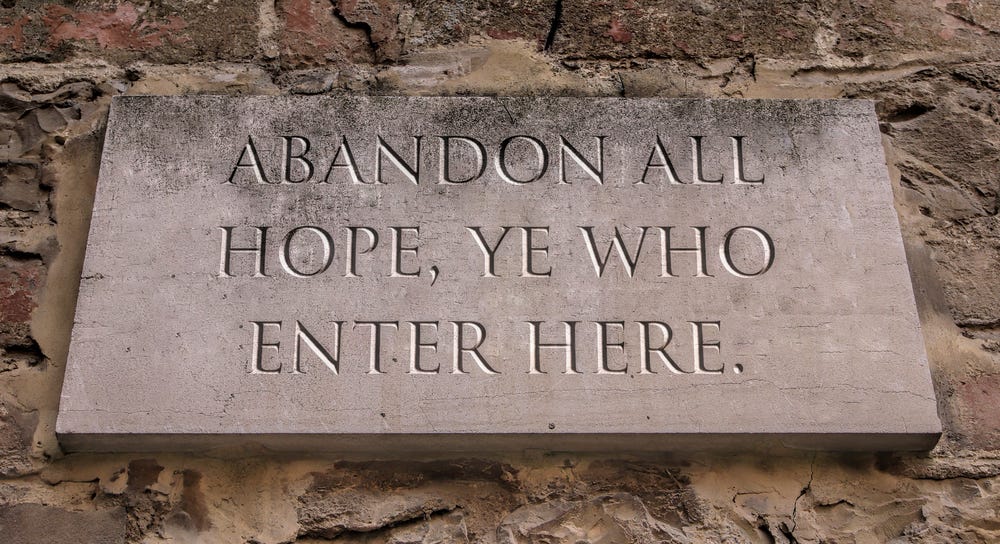E-Pluribus | June 27, 2023
Indoctrination, American style; expanding the definition of 'social justice'; and the coming edupocalypse.
A round-up of the latest and best writing and musings on the rise of illiberalism in the public discourse:
Eric Kaufmann: The Indoctrination of the American Mind
The Indiana chapter of Moms for Liberty recently shot itself in the foot by citing Adolf Hitler in its first newsletter with his observation, “He alone, who OWNS the youth, GAINS the future.” Citing a genocidal maniac is always a risky proposition, but the sentiment is clearly a fundamental position of the education establishment as it strives to shape the future through the indoctrination of students. Eric Kaufmann (without citing Hitler) makes this point for the Free Press.
We asked a random national sample of 18- to 20-year-olds whether they had heard (from an adult in school) of pro–Critical Race Theory (CRT) concepts such as “white privilege” or “systemic racism” as well as radical gender concepts such as the idea that gender is separate from biological sex. An astounding 90 percent had been exposed to CRT and 74 percent to radical gender concepts at school. In 7 of 10 cases these beliefs were presented as fact, or as the only respectable view to hold.
Why does this matter? Increasingly, evidence is pouring in that young people are intolerant of opposing views.
For instance, nearly 70 percent of undergraduates polled in a 2021 study said that if “a professor says something students find offensive,” they should be reported to the university. The massive Foundation for Individual Rights and Expression (FIRE) surveys of 2020–2022 find that 65 to 85 percent of American undergraduates believe universities should not permit speakers on campus who argue that some transgender people have a mental disorder, BLM is a hate group, or abortion should be illegal.
When compared to older age groups, young people are far more intolerant, even when taking their politics into consideration. As I show in this report, over two-thirds of 18- to 25-year-olds think Google was right to fire programmer James Damore in 2017 for raising evidence-based questions in an internal memo about the firm’s gender equity policy. This compares to just 36 percent of those over 50 who backed Damore’s termination. Among liberals, I found that 82 percent of 18–25-year-olds support his firing while a much lower 57 percent of liberals over 50 do.
Not only are educated young people intolerant of opposing ideas, they are increasingly unwilling to date or befriend Republicans. According to original data that I analyzed from FIRE’s 2020 survey, just 7 percent of female and 19 percent of male college students who are not Republican would feel comfortable dating a Trump supporter.
Read the whole thing.
Carole Hooven: Academic Freedom Is Social Justice
Dr. Carole Hooven of Harvard University writes at length at Tablet Magazine about her dispiriting (and lonely) experiences as an academic who dares to buck the narrative and speak up for facts. Hooven recalls how Harvard University President (now Emeritus) Larry Summers’s 2005 remarks about men and women foreshadowed the mess we find ourselves in almost two decades later.
When Larry Summers talked about “intrinsic” sex differences in 2005, he stirred up sentiments that foreshadowed the response to my statements in 2021 about what it means to be male or female. Summers expected disagreement and debate from his fellow scholars, and he did get that. But rather than using evidence and argument to illustrate why he might have been wrong, or even debating the proper limits on the speech of a university president, many also (or only) expressed moral outrage, using words like “offended,” “furious,” and “upset,” in response to his “hogwash” claims that “feed the virulent prejudices.”
In 2005, questioning the idea that the sexes are psychologically identical was taboo in some circles, and those who violated it were seen as immoral. This prohibition, this taboo, made a certain kind of sense: “Bad science” has done real harms to women. If we refuse to even entertain the idea that women might be intellectually inferior to men in some way, the story goes, then we could prevent the harms to which such claims might lead.
Today, the taboo on straight talk about sex differences is still in place, but in a more extreme form. Now the act of simply comparing males vs. females contains a taboo idea: Sex is binary and biological. Just as talk about sex differences has been interpreted to be damaging to women’s rights, today straight talk about the reality of sex seems to be taken as damaging to transgender rights. If some activists believe that a denial of the reality of sex is necessary for transgender people to live in dignity, then one can understand the motivation to shut down discussion.
[ . . . ]
While some who are fighting for the rights of gender minorities may sincerely believe that subverting science is necessary to protect an oppressed or endangered population, department chairs and university presidents are tasked with ensuring that the campus environment is one in which the fundamental ideals of truth-seeking and academic freedom are not only defended, but actively promoted. It should not be too much to ask that they firmly hold the line between ignorance and knowledge, between subjective and objective, between our feelings and the facts.
University administrators, like everyone else, are sensitive to threats to their reputations and job security. But a firm and unequivocal policy can help to offload the administrator’s responsibility, allowing her to say that she is simply applying the settled rules.
Read it all.
Peter Wood: After College
Correlation does not equal causation, but Peter Wood at Quillette notes that the decline of higher education is being accompanied by a movement to diminish the importance of a four year degree as an indicator of future success for young people. Wood examines the reasons for the trend and also what preparing for life might look like in the post-college world of tomorrow.
Going to college still looks to most Americans as a better choice than going to war or a life of dissolution, but recent evidence suggests that students completing high school are beginning to rethink the idea that college is necessarily the best path. “More High-School Grads Forgo College in Hot Labor Market” declares the Wall Street Journal. There’s that, but American higher education—and perhaps education throughout the Anglophone world—is in the midst of a transformation that goes beyond the vagaries of the job market.
[ . . . ]
We are witnessing the transition from “college is for everybody” to “college is unnecessary and often useless.” Going to college “to be able to get a better job” is likely to fade away as the primary reason students attend. And the institutions themselves—universities and colleges of various types—will have to accept a much less prominent role in our social and economic systems. They are in danger of becoming cultural relics.
[ . . . ]
It is a place where certain ideologies are so far in ascendency that they cannot be discussed let alone criticized: America’s endemic racism, climate-change catastrophism, and patriarchy lead the list. These should be understood not as systems of belief so much as symptoms of cultural confusion. Contemporary college is so lacking in a coherent intellectual core that anything that students run into that rings of passionate advocacy wins admiration. Black Lives Matter zealotry, transgender raving, antisemitic bloodlust, and postcolonial or indigenous fabulism each attract cultic worshippers who mistake their idols for “critical thinking.” Why not? They have been brought up to believe that “critical thinking” means attacking whatever stands in the way of today’s version of “social justice.”
But this is not to say that contemporary college is best understood as radical indoctrination. Radicalism is definitely present, but it is really just the helium that inflates the balloon of contemporary education. If it weren’t one vapid ideology, it would be another. The balloon itself is the emptiness of a college education.
My portrait of the mainstream is not to be taken as a sketch of just one type of college. Flagship state universities, small public colleges, Ivy League principalities, elite liberal arts colleges, ordinary private colleges, and to some extent even two-year colleges are all part of the great empty balloon of contemporary higher education.
But to say that contemporary higher education is empty of worthy civilizational content and susceptible to ideological substitutes is not to say that it is unappealing. Millions of students still want that “college experience.” But it is losing its luster.
Read it all here.
Around Twitter
Via the Foundation for Individual Rights and Expression, a federal court agrees with Yale’s “yes, we believe in free speech and academic freedom, but…” defense:
The Cringe Factor makes it hard to tell if Rick Scott is just trying to be funny or not, but in any case, Conor Friedersdorf is not having any of it (click for the video if you dare):
And finally, how crazy would it be if politicians routinely addressed daily lived realities, as perceived by the public? Too crazy for one Canadian professor, apparently:









